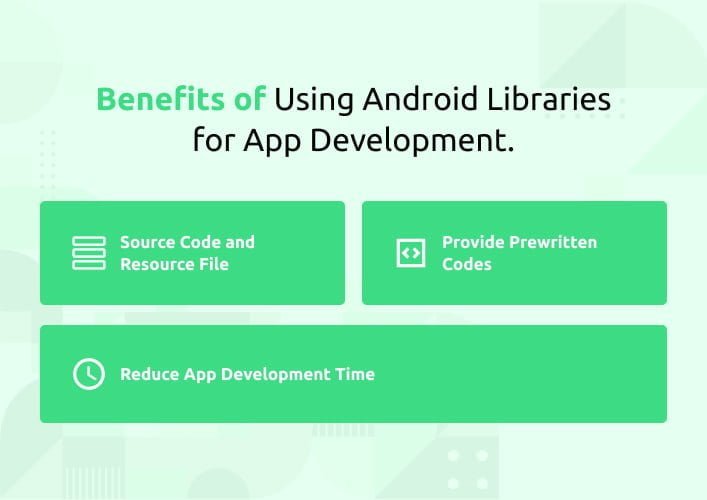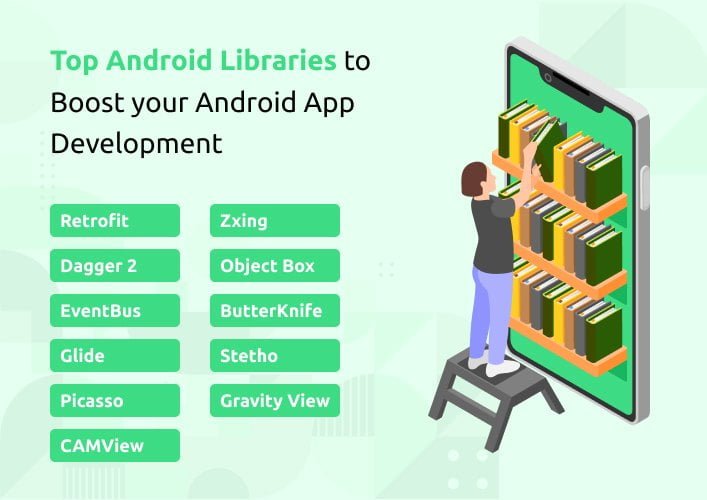Reasons to use Android Libraries

Android libraries more generally, are a collection of code that implements a certain function with a specific set of rules for how that library should be used. Common types of data stored in libraries consist of instructions, settings, messages, templates, values, code, help information, sub-routines, and classes. The main benefit of utilizing these libraries is that they let you create a fantastic app for Android quickly and efficiently. You don’t have to put in any extra time or effort in writing scripts.
This blog will help if you’re just beginning in the field of Android app development and are interested to learn more about the prominent android libraries used by every mobile app development company.
List of best Android Libraries

Retrofit
Retrofit is a networking library for Android that uses annotations to accurately map an API to a client interface. In the past, making a network request meant executing an Async task class and then using HttpsUrlConnection to get data. Thus, it was inefficient when working with APIs that returned big amounts of data. When Retrofit was introduced, this problem disappeared. Annotations alone in Retrofit are all that’s required to easily modify headers, request bodies, and query parameters, and choose between several request methods.
Dagger 2
Dagger 2 is a dependency injection library. It is based on JSR 330 and uses annotations. It uses Java annotation interpreters with compile-time analysis to predict and evaluate dependencies. By using annotations like @Inject you can create fields. By @Module you can construct objects and give dependencies.
EventBus
It’s possible to encounter a wide range of communication problems while you work on an Android app with several dynamic elements. EventBus is specifically designed to address this problem by Greenrobot. EventBus has improved and streamlined the process of sharing information across components, decouples, transmitters, and collectors. Furthermore, it works splendidly with background threads. There are also some highly advanced extras, such as delivery threads. Life cycle difficulties and complicated dependencies are avoided.
Glide
The Bumptech team manages this highly-rated image loader and cache library called Glide. Glide facilitates the decoding and display of media such as video calls, photos, and animated GIFs. The primary goal of this android library is to provide a seamless scrolling experience for any photo collection. Moreover, it works well if you need to download, resize, or show a picture.
Picasso
Picasso is a popular and reliable Android image library. It asserts to enable easy picture loading into the app, sometimes using just a single line of code. Picasso avoids common issues by automatically managing memory and caching, handling ImageView, and many more. Additionally, it efficiently and painlessly transforms pictures so they may be used in other layouts and take up less space in storage.
CAMView
The CamView library has a collection of ready-to-use components. It can be included in your layout files, providing instant access to the camera’s live preview, barcode scanning helped by ZXing’s in-built decoder, and real-time camera data processing.
Zxing
ZXing is an android library for processing barcode images. It is used by Google as well to index millions of barcodes online. It is written in Java but has been extended to other languages. Other barcode types, including 1D product, 1D industrial, and 2D, are supported by this library as well.
Object Box
Object Box is a data-binding library for Android. It frees up your important time so that you can focus on the USPs rather than backup and restore data. This library is like a substitute for SQLite. Furthermore, it is a good fit for IoT.
ButterKnife
ButterKnife is a popular view-binding support library. It makes setting ids to views relatively simple, saving developers from using findViewByid. ButterKnife uses annotations to produce boilerplate code.
Stetho
This library is used by programmers to access the Chrome Development Tools capabilities that are included in the Chrome desktop browser. Furthermore, android developers have the option of using the dump app tool, which provides robust command-line access to the app’s internal components.
Gravity View
The Gravity View is now trendy. For Android, this library provides a user interface for tilting images with the use of sensors. The purpose of the Gravity View library is to put Android’s motion sensors to work, letting users do tasks by simply tilting or turning their smartphones.
Conclusion
Thus, these are a few Android libraries that might be quite helpful to Android programmers. With these libraries, programmers may effortlessly and quickly create highly functional and responsive mobile applications.
FAQs
Which Android library is best?
What are third-party libraries in Android?
Where are shared libraries in Android?
system/vendor/lib.
What is Robolectric?
What is AnimatedPieView?
Ravi Bhojani is the Chief Marketing Officer (CMO) at Alian Software, where he spearheads the company’s marketing strategies and drives its brand presence in the competitive IT services landscape. With over a decade of experience in the technology and marketing sectors, Ravi has consistently demonstrated his ability to blend innovative marketing techniques with deep industry knowledge to deliver outstanding results.